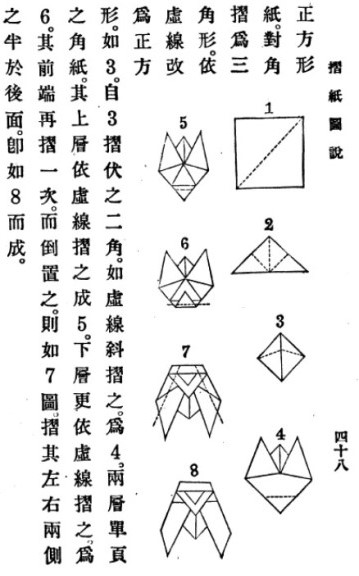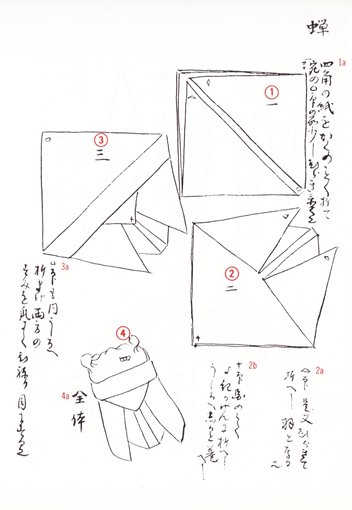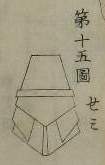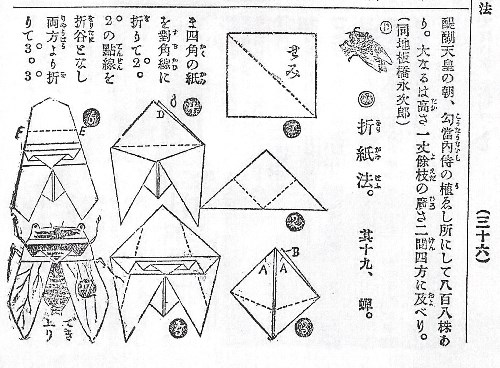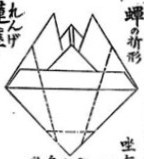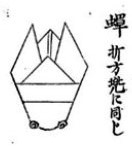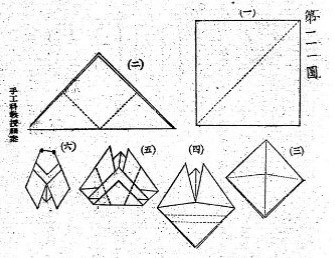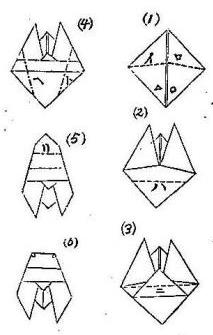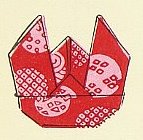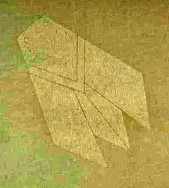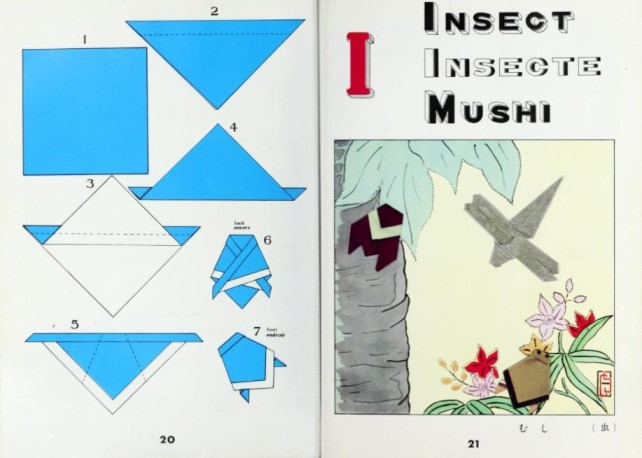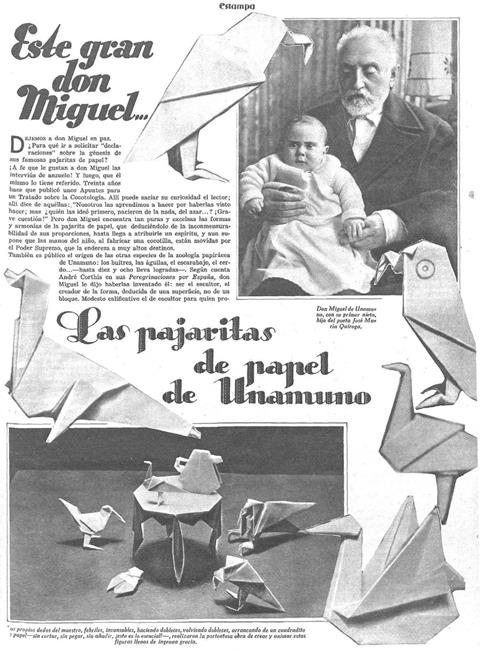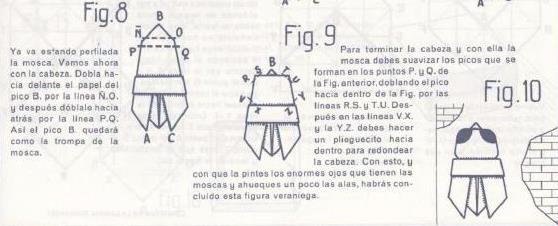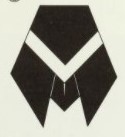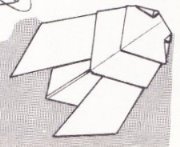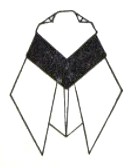| The Public Paperfolding History Project
Last updated 16/3/2025 x |
|||||||
| The Kabuto Base Cicada / La Mosca | |||||||
| This
page attempts to record what is known about the origin
and history of the design that I call the Kabuto Base
Cicada because it is developed from the same initial
folds as the Kabuto. Please contact me if you know any of
this information is incorrect or if you have any other
information that should be added. Thank you. ********** In China (and in publications by Chinese authors) 1914 Diagrams for a version of this design, titled 'Cicada', appear in 'Zhe zhi tu shuo' (Illustrated Paperfolding), compiled by Gui Shaolie, which was published by the Commercial Press in Shanghai in Ming guo 3 (1914).
********** In Japan (and in publications by Japanese authors) 1845 As far as I am aware the earliest diagrams for a cicada design appear on page 36 of the Kan No Mado, which is usually dated to 1845. It is one of only a handful of designs in this manuscript that is folded from an uncut square. The instructions say, 'Twist both corners with fingernails to make the eyes.'
********** 1885 A drawing of a similar cicada appears in 'Kindergarten Shoho' (Preliminary Kindergarten) by Iijima Hanjuro, which was copyrighted on October 4th Meiji 17 (1884) and published by Fukuda Senzo in August of Meiji 18 (1885).
********** 1894 This design appears as 'Semi' (Cicada) in issue 3 of the children's magazine 'Shokokumin' for the year 1894.
********** 1905 Diagrams also appear in 'Shukouka Kyohon : Liron Jishuu Souga Setsumei' by Kikujiro Kiuchi, Rokushiro Uehara and Hideyoshi Okayama, which was published by Shigebei Takase in Chiba in 1905.
********** Diagrams also appear in 'Shukoka Kyoju Saian' by Gentaro Tanahashi and Hideyoshi Okayama, which was published by Hobunkan in Tokyo in 1905.
********** 1908 Diagrams also appear in 'Origami zusetsu' (Illustrated Origami) by Sano Shozo, which was published in Tokyo in 1908.
********** 1912 A drawing of a version of the Cicada appears in a monozukushi-e print, by an unknown artist, but said to be from the Meiji era. I have temporarily assigned it the date of 1912, the last year of that era, pending the discovery of more accurate information.
********** 1931 Another version appears in 'Origami (Part 1)' by Isao Honda, which was published in Japan in 1931.
********** 1935 'Origami Moyo, Book Two' by Kawarazaki Kodo, which was published in Japan in 1935, contains a print showing the Kabuto-base Cicada.
********** 1944 The design also appears in 'Origami Shuko' by Isao Honda, which was published in 1944.
********** 1951 As 'Cicada' in 'Origami to Kirinuki' by Saburo Ueda, which was published by Kokkado in Tokyo, most probably in 1951.
********** An illustration of a colour-changed version of the Kabuto Base Cicada appears in 'Origami: Folding Paper for Children' by Claude Sarasas, which was first published by Kodansha in Tokyo in 1951. (The diagrams are for a Crossover Cicada design.)
********** In Western Europe and the Americas 1928 A design called 'la mosca' (the fly) appeared in an interview with Unamuno entitled 'Miguel de Unamuno - der Baskische Bildhauer' (the Basque Sculptor), by Edda Reinhardt, which was published in October 1928 in Berlin in the avante-garde magazine 'Der Querschnitt'. The full article can be read, in the original German and in Spanish and English translations, here. This design appears to be a version of the Kabuto Base Cicada design, although it was most probably originated independently by Unamuno.
********** 1932 'La mosca' also appears in a photograph in an article about Unamuno in the magazine 'Estampa', which was published in Madrid on 3rd December 1932.
********** 1951 The extended version of 'El Mundo de Papel' by Dr Nemesio Montero, which was published by G Miranda in Edicions Infancia in Valladolid in 1951, also contains the 'La Mosca' design and attributes it to Miguel de Unamuno.
********** 1961 'The Art of Origami' by Samuel Randlett, which was published by E P Dutton in New York in 1961, contains instructions for making a Kabuto Base Cicada with a colour-changed stripe across its back. It is identified as a traditional Japanese design.
********** The design also appears: 1964 In 'Secrets of Origami', by Robert Harbin, which was published by Oldbourne Book Company in London in 1964.
********** 1965 A variation titled 'Locust' appears in 'The World of Origami' by Isao Honda, which was published by Japan Publications Trading Company in the USA in 1965.
********** 1968 In 'Your Book of Paperfolding' by Vanessa and Eric de Maré, which was published by Faber and Faber in London in 1968, where it is said to be a traditional Japanese design..
********** |
|||||||
